Votive Bodies: Making Space
Michelle Oing
Flat golden limbs and organs hang from a metal frame. Two arms of beaten metal reach down towards the raised arms of Sophie Dupont. She takes her place in the center of a growing circle of onlookers, drawn by the body parts as they pass. A hush descends almost immediately in spite of the food vendors and conversations about the museum’s event. The deliberateness of Dupont’s movements, the glint of the limbs, the black-and-white simplicity of her garment: these are signifiers, even if we do not know yet what they are for.
Dupont stands holding the metal frame and its bodies for several minutes; the crowd watches, as they have been taught to do when faced with ‘art’. But then, slowly, the atmosphere shifts and someone steps forward. She removes a pair of metallic lungs, beaten around the edges, and places them in the top left corner of the brown cloth on the ground. Others follow, disassembling the duplicate body and laying its parts on the cloth. Golden intestines are placed next to arms, legs, eyes, kidneys; a fragmented portrait appears.
When all the limbs and organs have been placed before her, Dupont lifts up the black frame from which they hung and, in turn, hangs it up. Then she greets the second body again, placing her feet on their metal doubles, on the lungs, the arms, the ears. She presses them with her hands: she takes care to touch each one. In the end, she raises the brown cloth to reveal indigo imprints left on the cloth by the organs, a fragmentary trace.
In the performance described above – We Always Carry Our Body – there are multiple bodies, both Dupont’s own and those doubles which she carries on the frame. Moreover, there are the bodies of the audience whom she relies on to touch and move the metal limbs. Marking Breath is an exercise in elevating the body into an instrument. My Weight in Salt and Heavy Light explore the body’s way of taking up space, its presence both physically and experientially (F, G). Throughout these performances and others, Dupont’s own body is both the anchor and the source, the fulcrum for exploration.
Although each performance is an exercise in presence, it also echoes the history of all bodies that have ever been, ever breathed, ever taken up space. We Always Carry Our Body makes use of the ex-voto format to create this blend of past and present/presence. Ex-votos are a transcultural and transhistorical phenomenon found everywhere from Babylonian archaeological sites to the churches and cathedrals of modern Latin America. They are offerings (ex meaning ‘from’, and votum meaning ‘vow’) made by humans and most often directed towards deities. Although they take on many forms – including statuettes of humans or animals, or painted tablets – isolated limbs and organs seem to be their most striking form.[1]
In the Christian West, ex-votos were often placed around the shrine of a saint, or hung from the railings surrounding it, where they stood as permanent testimonials to the saint’s efficacy. These arrangements can be seen today in stained glass – in York Minster, for example, where several panels of the life of William of York show the saint’s tomb adorned with fragmented limbs – and in woodcuts such as a French rendition of Saint Anthony from around 1500 (figs. 1 and 2). In this image, the saint stands larger than life and his haloed head is framed by a row of diverse votives: arms, legs, swaddled children, and even a few tiny boars. Along with the pilgrims kneeling beside him, these are the witnesses to his healing powers.
This frame of limbs is echoed in Dupont’s performance of We Always Carry Our Body, as she processes through the entrance of the National Museum, the golden milagros borne aloft above her head.[2] In some ways, she could be said to be taking the position of the saint, centered and serene amidst these offerings; and yet the act of carrying them, of physically shouldering their weight, also suggests her relationship to the shrine as a place. Her own body is covered by a white robe marked with black outlines and shapes of limbs, so that she mirrors the fragmentation of the golden limbs and organs. At this moment in the procession, she is not so much the ‘saint’ as she is the site of the miracle, the material body that is its trace.
This robe also serves as a ritual marker. It is a subtle indication of what is yet to come: when the audience will create another robe spread on the floor, covered in limbs. Indeed, the ritual embedded in this performance makes it difficult to speak of a strict separation of ‘performer’ and ‘audience’ – it becomes immersive, the audience becomes performers, too, not only for Dupont, but for themselves and each other.
The ex-voto is an object created out of a crisis – a bodily injury, illness, or pain. It persists, however, as both personal and general, past and future. It is personal, because in the act of giving it, the donor transforms it into a portrait of sorts – even if it is simply a generic leg, the context anchors it to an individual. And yet, it is general because, displayed with all the others, divorced from its original donor, it becomes simply ‘a leg’ made whole again. It is the past, hinging on the moment of crisis and yet, it is the future in its completeness, in the fulfilment of the hope of healing.[3]
In Dupont’s performance, the moment of crisis is no longer at the center of meaning. Nevertheless, the ex-voto holds on to the simultaneity of opposites, the tension of, all at once, being individual and general, past and future. Through the performance, the moment of crisis is resolved, reverse-engineered in a sense, so that through Dupont’s collaboration with the audience-cum-participants, the body is made whole even in its fragmentation.
The metal body parts hanging above Dupont’s head are not her own, in a literal sense. Her own physical body is still visible: it moves and directs the actions which follow. And yet, they are hers: she made them, she carries them, she handles them with care and attention. They are shifting things, however, for as soon as the viewers become participants – that is, as soon as they select an arm or an eye and remove it from the frame – these bodies become part of the viewers, too. They carry them, they handle them with care, they place them in a new context. The metal eye or lung is, at that moment, a communal object: it belongs, however briefly, to Dupont, to the person who touches it, to no one at all. A new body is being created, both on the cloth and in the space.
Near the end of the performance, Dupont touches each fragment again so that even though they lie disjointedly on the ground, they are brought together again. Her movements and her touch re-establish the connection between the body parts and herself and, through this, also affirm her connection with the ‘audience’: the three bodies are linked.
Finally, we see that this connection has left a trace, an imprint, even as the metal pieces fall away. A deep blue is revealed on the ground, and then it’s negative. The pieces have left behind imperfect and incomplete traces: signs that ‘somebody’ was here. This material trace – like the cloth which Veronica used to wipe the face of Christ when he stumbled, the cloth which then bore the likeness of him (the sudarium); or like the footprints of the Buddha, indices of his body spread across Asia – is presence in absence, which persists even when the ritual is long over and the museum is empty.
Marking Breath is an exercise in the body’s presentness, its persistence, and how one can make room for this body within oneself (H). Much as in We Always Carry Our Body, Dupont attempts to leave room for her own body as well as the bodies of those around her. Sitting from sunrise to sunset, the act of making lines on the shimmering surface of the metal panel is, at once, an archive and an action. Like the metal limbs and organs of We Always Carry Our Body, the panel, with its spiral of short, neat hatch marks, is a trace (I). It speaks to her body’s presence, measured in time and in breath – the former, a discrete manmade system of counting; the latter, an organic subconscious process, the very stuff of life.
Medieval pilgrims in the West left many things in shrines, not only ex-voto limbs; they also donated candles made to their own measurements (ad mensuram corporis). A woman who was ill, for instance, would have her body measured, and its length would then become the wick of a candle. She might also be weighed and then give a lump of wax of the same weight.[4] The body as offering: but here, it is simplified to weight and measure, to the calculable units of human ingenuity.
The marks of Dupont’s Marking Breath are, like the candles as tall as their donors, indices of being. They are numerical and yet, as the day goes on and their number increases, they exceed this function and become a form unto themselves. Dupont’s breaths are transformed into ornament and the final trace of the project – the metal panel itself – could stand alone as a design feature (J). The reflective metal catches the light in the marks, as uniquely – and as bodily – as a fingerprint. Its apparent independence as a piece of art belies its process (K).
In his studies of the art of non-Western cultures in the early twentieth century, the anthropologist Franz Boas wrote that ‘the artist has not in mind the visual effect of his work, but … is stimulated by the pleasure of making a complex form.’[5] That is, form precedes meaning: the artist finds a bodily rhythm that is pleasing and that produces pleasing forms. Ornamentation, design, pattern – all of these are born of, and limited by, the body’s movement.
Dupont’s Marking Breath makes this clear: breathing is transformed into the movement of the hand, and this, in turn, is transformed into an external trace. Like the wax that weighs the same as the pilgrim, the metal panel is both an external ‘thing’ and an intimate one; it is not her body and yet, one cannot say that it has nothing to do with that body. It is a record of her breath, and her hand, and her time, just as the wax is a record of a real body, suffering yet hopeful.
Is a lump of wax the same weight of a body any less a portrait than a naturalistic oil painting? Today it is common to speak of likeness in terms of the visual – a privileging of sight. But what about the other senses?
In Gravity and Heavy Light, in Marking Breath, in We Always Carry Our Body, the body – Dupont’s body, as well as its surrogates measured in weight, or form, or as an index – is both an individual portrait and a universal symbol. Her work recognizes, elevates, celebrates that the body is something that we are and yet something that we do not fully know. To watch her performances is to be asked to see this body, as well as our own, in all its familiarity and strangeness.
All performance is based on the body and yet, to make the body both the site and the protagonist of the performance is something else, entirely. To do this is a balancing act: the performer must consider the body as both a part of herself, and as something separate. She must seek to provide enough slack so that the body can make discoveries and yet she must also provide enough control so that these discoveries can be legible, recognizable, productive. Her task is not unlike that of the puppeteer, who must balance her desire to make the puppet move with the natural inclinations of the puppet as an object. The performer who wishes to provide space for the body must allow that body to explore its own limits – and perhaps even transgress them.
The work of Sophie Dupont does just that, and through
the opportunities that her body provides as both site and actor, we are made
aware of our own bodies. We become aware, too, that our bodies are not as
closed off as we had imagined – they are porous, they blend, and all bodies are,
at once, both the same and different. Bodies are not the static flesh-and-blood
entities that are found within the pages of medical textbooks: they are
shifting, dynamic things and their limits are changing, too.

Fig. 1
St William window (nvII), panel 22b
York Minster
England, c.1415
Source: Corpus Vitrearum Medii Aevi Picture Archive, www.cvma.ac.uk
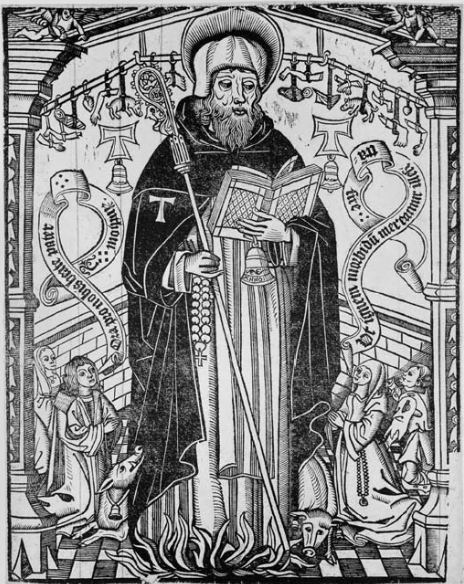
Fig. 2
St Anthony
France (?), c.1500
Woodcut
Ashmolean Museum, Oxford, UK
Images
from Sophie Dupont’s performances (taken from website)
We Always Carry Our Body, 2016, National Gallery of Denmark
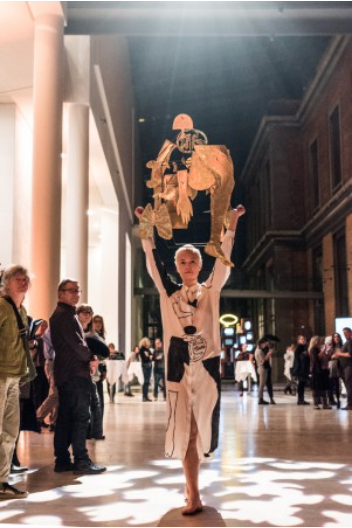
A
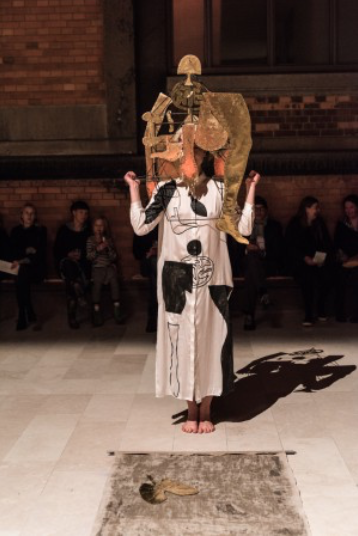
B

C
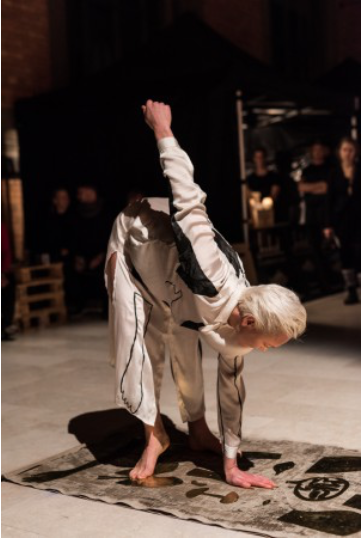
D
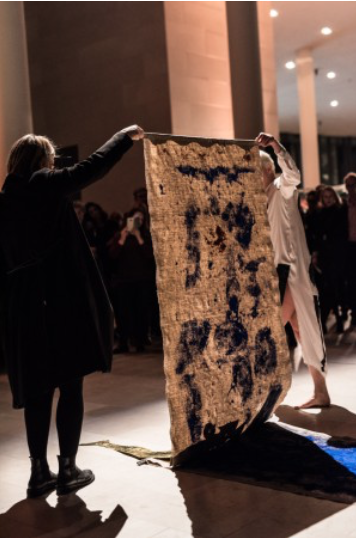
E
Heavy Light, 24.9.2016, Horsens Art Museum, Denmark
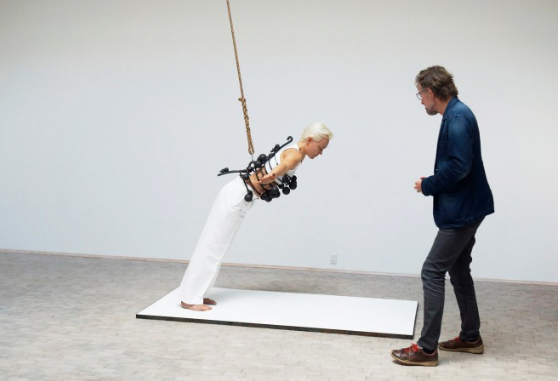
F
My Weight in Salt Transformed into Cut Piece, Den Frie, 2013, Copenhagen
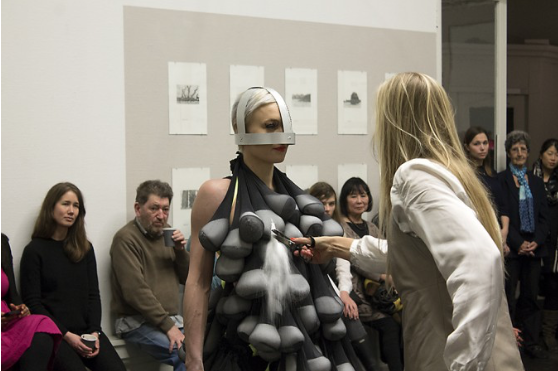
G
Marking Breath, 25.2.2017, Guatemala City
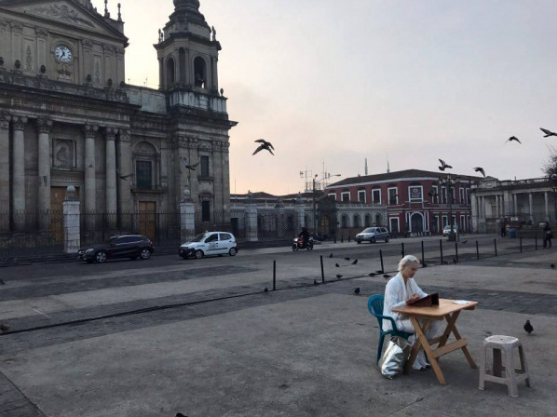
H
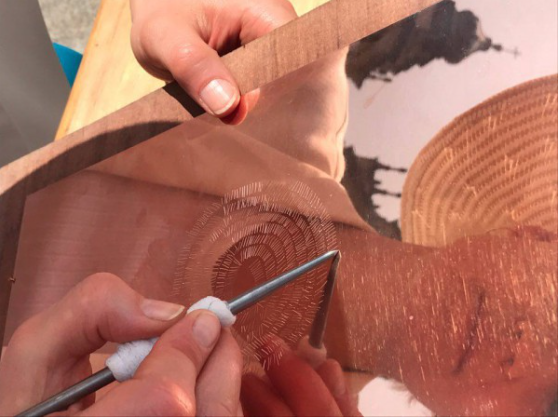
I
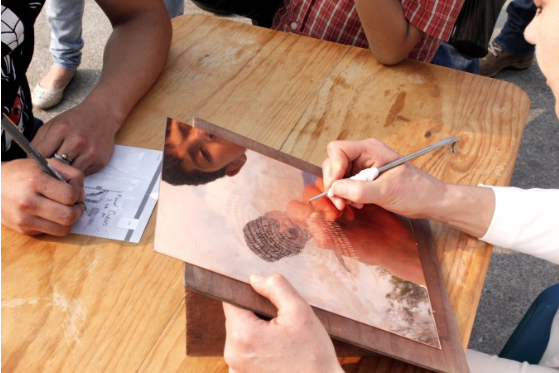
J
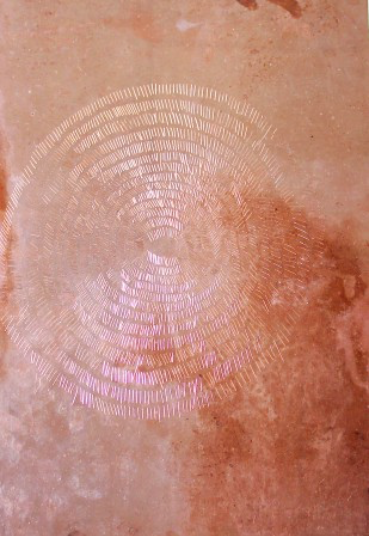
K
Michelle Oing is a PhD-candidate
in the History of Art at Yale University (CT, USA), studying under Professor
Jacqueline Jung. She received her B.A. in Art History from Brown University (RI,
USA) and her M.T.S. in the History of Christianity from Harvard Divinity School
(MA, USA). Her dissertation, The
Reliquary and the Puppet: Visual and Kinetic Mimesis in Medieval and Early
Modern Sculpture, argues for a more critical understanding of medieval and
early modern conceptions of mimesis through an examination of a range of
figural objects: bust reliquaries, moveable sculptures of Christ and the
saints, mobile effigies, and puppets and automata.
[1] There are numerous works on ex-votos and other offerings in a variety of eras and cultures. A good general overview can be found in the museum catalogue Ex voto tra storia e antropologia: atti del convegno promosso dal Museo nazionale delle arti e tradizioni popolari e dall’Associazione italiana di studi storico-antropologici, ed. Emilia de Simoni, Rome: De Luca, 1986. A more recent volume which treats votives from around the world is Bodies of Evidence: Ancient Anatomical Votives Past, Present and Future, ed. Jane Draycott, London, New York: Routledge, 2017.
[2] Milagros are a Latin American form of Catholic votive offering, most often made from beaten tin or other inexpensive metals. A special issue of the journal Artes de México gave an overview of Mexican examples: ed. de Orellana, Margarita, “Ex-votos,” Artes de México, n. 53 (2000): 81-96.
[3] Christopher Wood discusses the particular temporality of the ex-voto in his article “The Votive Scenario,” Res 59/60 (2011): 206-227. Georges Didi-Huberman also addresses it in his “Ex-Voto: Image, Organ, Time,” L’esprit créateur, 47.3 (2007): 7-16.
[4] Ronald Finucane discusses these practices for medieval England in his Miracles and Pilgrims: Popular Beliefs in Medieval England, London: Rowman and Littlefield, 1977, but the practice was widespread throughout Europe.
[5] Franz Boas, Primitive Art, New York: Dover Publications, 1955 (original 1927):25.
